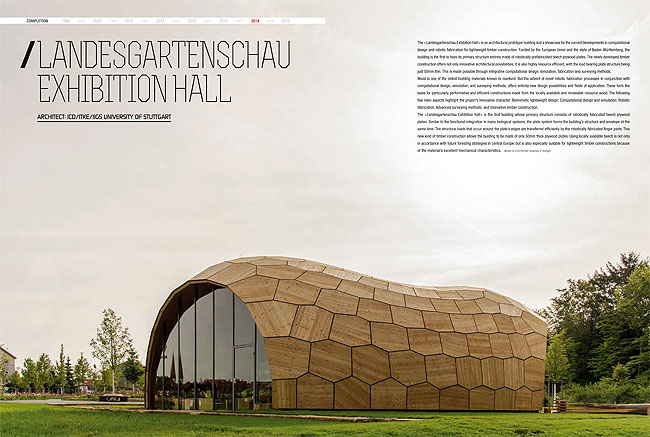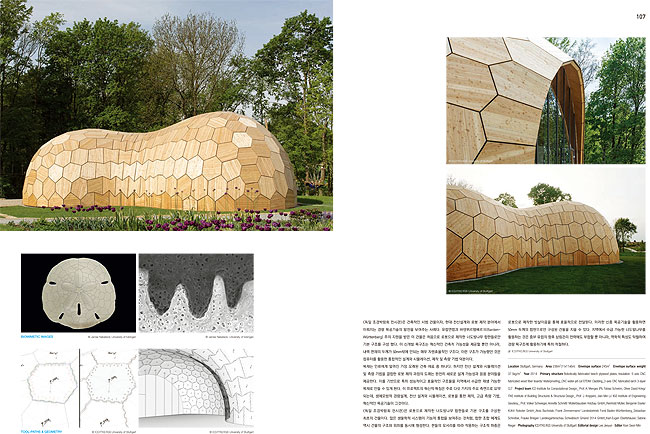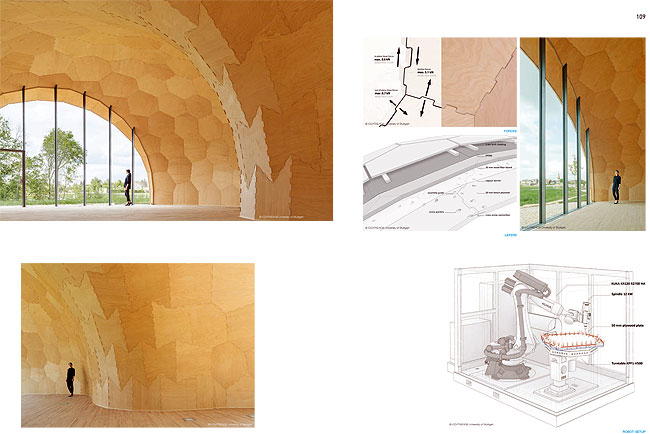Landesgartenschau Exhibition Hall
Architect : ICD/ITKE/IIGS University of Stuttgart



<독일 조경박람회 전시관>은 건축적인 시범 건물이자, 현대 전산설계와 로봇 제작 분야에서 이뤄지는 경량 목공기술의 발전을 보여주는 사례다. 유럽연합과 바덴뷔르템베르크(Barden- Wurttenberg) 주의 지원을 받은 이 건물은 처음으로 로봇으로 제작한 너도밤나무 합판들로만 기본 구조를 구성 했다. 이 신개발 목구조는 혁신적인 건축적 가능성을 제공할 뿐만 아니라, 내력 판재의 두께가 50mm밖에 안되는 매우 자원효율적인 구조다. 이런 구조가 가능했던 것은 컴퓨터를 활용한 통합적인 설계와 시뮬레이션, 제작 및 측량 기법 덕분이다.
목재는 인류에게 알려진 가장 오래된 건축 재료 중 하나다. 하지만 전산 설계와 시뮬레이션 및 측량 기법을 결합한 로봇 제작 과정의 도래는 완전히 새로운 설계 가능성과 응용 분야들을 제공한다. 이를 기반으로 특히 성능적이고 효율적인 구조물을 지역에서 수급한 재생 가능한 목재로 만들 수 있게 된다. 이 프로젝트의 혁신적 특징은 주로 다섯 가지의 주요 측면으로 요약 되는데, 생체모방적 경량설계, 전산 설계와 시뮬레이션, 로봇을 통한 제작, 고급 측량 기법, 혁신적인 목공기술이 그것이다.
<독일 조경박람회 전시관>은 로봇으로 제작한 너도밤나무 합판들로 기본 구조를 구성한 최초의 건물이다. 많은 생물학적 시스템이 기능적 통합을 보여주는 것처럼, 합판 조합 체계도 역시 건물의 구조와 외피를 동시에 형성한다. 판들의 모서리를 따라 작용하는 구조적 하중은 로봇으로 제작한 빗살이음을 통해 효율적으로 전달된다. 이러한 신종 목공기술을 활용하면 50mm 두께의 합판으로만 구성된 건물을 지을 수 있다. 지역에서 수급 가능한 너도밤나무를 활용하는 것은 중부 유럽의 향후 삼림관리 전략에도 부합할 뿐 아니라, 역학적 특성도 탁월하여 경량 목구조에 활용하기에 특히 적절하다.
글: ICD/ITKE/IIGS University of Stuttgart
The [Landesgartenschau Exhibition Hall] is an architectural prototype building and a showcase for the current developments in computational design and robotic fabrication for lightweight timber construction. Funded by the European Union and the state of Baden-Wurttemberg, the building is the first to have its primary structure entirely made of robotically prefabricated beech plywood plates. The newly developed timber construction offers not only innovative architectural possibilities; it is also highly resource efficient, with the load bearing plate structure being just 50mm thin. This is made possible through integrative computational design, simulation, fabrication and surveying methods. Wood is one of the oldest building materials known to mankind. But the advent of novel robotic fabrication processes in conjunction with computational design, simulation, and surveying methods, offers entirely new design possibilities and fields of application. These form the basis for particularly performative and efficient constructions made from the locally available and renewable resource wood. The following five main aspects highlight the project’s innovative character: Biomimetic lightweight design, Computational design and simulation, Robotic fabrication, Advanced surveying methods, and Innovative timber construction.
The [Landesgartenschau Exhibition Hall] is the first building whose primary structure consists of robotically fabricated beech plywood plates. Similar to the functional integration in many biological systems, the plate system forms the building’s structure and envelope at the same time. The structural loads that occur around the plate’s edges are transferred efficiently by the robotically fabricated finger joints. This new kind of timber construction allows the building to be made of only 50mm thick plywood plates. Using locally available beech is not only in accordance with future foresting strategies in central Europe, but is also especially suitable for lightweight timber constructions because of the material’s excellent mechanical characteristics.
Written by ICD/ITKE/IIGS University of Stuttgart
건축문화 2016년 2월호 [Monthly Issue]페이지 © 에이엔씨출판(주)